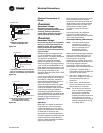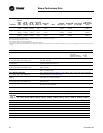
UH-SVX01A-EN 35
Electrical Connections
Figure 44.
Figure 45.
Figure 46.
MOTOR
MANUAL STARTING
SWITCH
3 PHASE LINE
MANUAL CONTROL WITH
THREE PHASE MOTOR
LIMIT CONTROLLER
REVERSE ACTING
THERMOSTAT
MOTOR
MANUAL STARTER
WITH BUILT IN
SELECTOR SWITCH
1 PHASE LINE
THREE POSITION SELECTOR SWITCH
BUILT INTO MAGNETIC STARTER FOR
MANUAL OR THERMOSTATIC CONTROL
LIMIT CONTROLLER
THERMOSTAT
MOTOR
MANUAL STARTING
SWITCH
1 PHASE LINE
THREE POSITION SELECTOR SWITCH
USED FOR EITHER MANUAL
OR THERMOSTATIC CONTROL
LIMIT CONTROLLER
SELECTOR
SWITCH
THERMOSTAT
Electrical Connections: S
Model
ƽWARNING
Hazardous Voltage
Disconnect all electric power
including remote disconnects before
servicing. Failure to disconnect
power before servicing can cause
severe personal injury or death.
ƽWARNING
Hazardous Voltage
Do not use any tools (i.e. screwdriver,
pliers, etc.) across the terminals to
check for power. Use a voltmeter.
Failure to disconnect power before
servicing can cause severe personal
injury or death.
Standard units are shipped for use
on 115 volt, 60 hertz single phase
electric power. The motor nameplate
and electrical rating on the
transformer should be checked
before energizing the unit heater
electrical system. All external wiring
must conform to ANSI/NFPA No. 70-
2002, National Electrical Code (or the
latest edition) and applicable current
local codes; in Canada, to the
Canadian Electrical Code, Part 1 CSA
Standard C22.1.
It is recommended that the electrical
power supply to each unit heater be
provided by a separate, fused and
permanently live electrical circuit. A
disconnect switch of suitable
electrical rating for each unit heater
should be located as close to the
controls as possible. Each unit heater
must be electrically grounded in
accordance with National Electric
Code, ANSI/NFPA No. 70-2002 (or the
latest edition) or CSA Standard C22.1.
Sample wiring connections are
depicted in Figure 49 through
Figure 57.
Operation
Most basic unit heater systems are
controlled by a room thermostat.
Locate thermostat on inner wall or
column so that optimum control can
be obtained for that area. Set
thermostat for desired temperature.
On steam systems a low limit may be
used to prevent fan from blowing
cold air unless the heater has steam
passing through the coil.
Small hot water systems could have
the circulating pump controlled
directly by the room thermostat. On
large systems, zone valves could be
used to control the individual unit
heater where constant water
circulation is used on the main
system.
Horizontal louvers are standard
equipment on horizontal unit
heaters, vertical louvers are available
as an optional accessory.
Thermostat Wiring and Location
Note: The thermostat must be
mounted on a vertical
vibration-free surface free
from air currents and in
accordance with the
furnished instructions.
Mount the thermostat approximately
5 feet (1.5 m) above the floor in an
area where it will be exposed to a
free circulation of average
temperature air. Always refer to the
thermostat instructions as well as our
unit wiring diagram and wire
accordingly. Avoid mounting the
thermostat in the following locations:
1. Cold areas - Outside walls or
areas where drafts may affect the
operation of the control.
2. Hot areas - Areas where the
sun's rays, radiation, or warm air
currents may affect control
operation.
3. Dead areas - Areas where air
cannot circulate freely, such as
behind doors or in corners.
Note: For all wiring connections,
refer to the wiring diagram
on the motor nameplate.
Should any original wire
supplied with the heater have
to be replaced, it must be
replaced with wiring material
having a temperature rating
of at least 105° C.


















